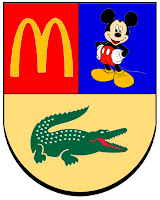Idle curiousity leads me to wonder about the precise way in which the bride and groom who married in Zaragoza in 1726 were connected. They were not Spanish, nor can one really characterise them as Belgian or German... In fact, the map of Europe has changed so much that it's a challenge to be consistent in describing their origins, as so few of the cities mentioned in connexion with this couple are today in the same nation-state as in 1726.
On June 3rd of that year, at Zaragoza's parish of San Felipe, Don Joseph Bureau, Adjutant-Major of the 'Regimiento de Mons', born at Montigny in the Diocese of Cambrai [Monteigny-Terlens, in the marriage licence index], married Francisca Alexandra Dusmet, native of Bonn, Diocese of Cologne. The witnesses were Don Santiago Genant and Don Francisco Loox.
The groom was a son of 'Don' Juan Bautista Bureau, and María Barbara Payllut; the bride, a daughter of Joseph Dusmet and Angela de Bureau. The latter couple left a considerable number of knightly descendants among Spanish officers; indeed their presence in Bonn when Francisca Alexandra Dusmet was baptised probably derived only from Joseph Dusmet's military career.[1]
The admissions file for a Dusmet who eventually became a Knight of the Order of Santiago reveals that the Dusmets were Sicilian in origin, so much of the paperwork they generated and which eventually ended up in Spanish archives originated elsewhere, was translated and legalised in Sicily, and then those copies were presented in Spain when required. From this file we learn that Angela Bureau (or Bureaux) was married in the city of Aalst (Alost, in the Spanish file) to Joseph Dusmet on 13 September 1695; she had been baptised in Aalst on 20 March 1677. But her parents, Jean Bureau and Anne Boyteux, married at Masnuy-Saint-Jean on 14 April 1670. Unfortunately, the marriage record does not name the parents of either spouse.
The paperwork from Zaragoza dispensing Joseph Bureau and Francisca Alexandra Dusmet of a 2nd with 3rd degree cousinship has been lost; I suppose Bureau is the most logical source of their kinship, but how? And, even more intriguingly - where? Do the two lines meet in Masnuy-Saint-Jean, in Aalst, or some other locality?
On June 3rd of that year, at Zaragoza's parish of San Felipe, Don Joseph Bureau, Adjutant-Major of the 'Regimiento de Mons', born at Montigny in the Diocese of Cambrai [Monteigny-Terlens, in the marriage licence index], married Francisca Alexandra Dusmet, native of Bonn, Diocese of Cologne. The witnesses were Don Santiago Genant and Don Francisco Loox.
The groom was a son of 'Don' Juan Bautista Bureau, and María Barbara Payllut; the bride, a daughter of Joseph Dusmet and Angela de Bureau. The latter couple left a considerable number of knightly descendants among Spanish officers; indeed their presence in Bonn when Francisca Alexandra Dusmet was baptised probably derived only from Joseph Dusmet's military career.[1]
The admissions file for a Dusmet who eventually became a Knight of the Order of Santiago reveals that the Dusmets were Sicilian in origin, so much of the paperwork they generated and which eventually ended up in Spanish archives originated elsewhere, was translated and legalised in Sicily, and then those copies were presented in Spain when required. From this file we learn that Angela Bureau (or Bureaux) was married in the city of Aalst (Alost, in the Spanish file) to Joseph Dusmet on 13 September 1695; she had been baptised in Aalst on 20 March 1677. But her parents, Jean Bureau and Anne Boyteux, married at Masnuy-Saint-Jean on 14 April 1670. Unfortunately, the marriage record does not name the parents of either spouse.
The paperwork from Zaragoza dispensing Joseph Bureau and Francisca Alexandra Dusmet of a 2nd with 3rd degree cousinship has been lost; I suppose Bureau is the most logical source of their kinship, but how? And, even more intriguingly - where? Do the two lines meet in Masnuy-Saint-Jean, in Aalst, or some other locality?
SOURCES - Order of Santiago Admissions File of Juan Nepomuceno Dusmet y Barragán - Marriages, Church of San Felipe, Zaragoza.
[1] This couple had at least one other daughter, Maria Theresa, baptised on 20 April 1701 at the Cathedral in Gerona; the ceremony was performed by the Chaplain of a unit - Legionum Ambarum - commanded by the Vicômte de Maulde, and the godparents were Gaspard Nicolas du Vandrenot and Therese de Montaumon. But their son Francisco, baptised in Torredembarra, Spain on 7 February 1696, was the source of the family's notable male-line descendancy in Spain.





















